Analysis of Medication Errors in Nursing: A Literature Review Report
VerifiedAdded on 2022/08/20
|11
|3493
|12
Report
AI Summary
This literature review examines medication errors in nursing, focusing on their prevalence, causes, and impact on patient safety. The review begins with an introduction highlighting the significance of medication errors as a critical outcome of poor medication management in hospital settings, particu...
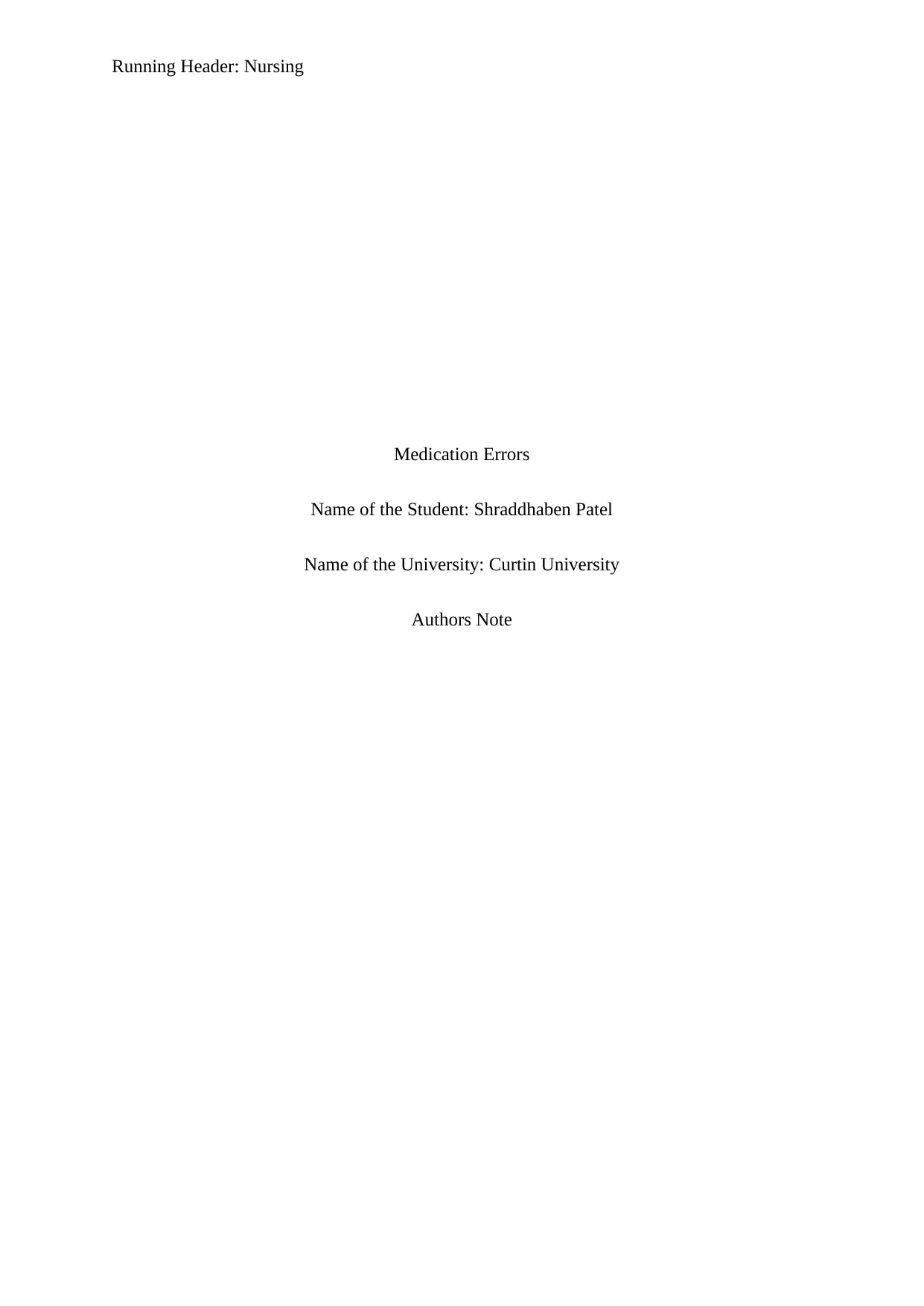
Running Header: Nursing
Medication Errors
Name of the Student: Shraddhaben Patel
Name of the University: Curtin University
Authors Note
Medication Errors
Name of the Student: Shraddhaben Patel
Name of the University: Curtin University
Authors Note
Paraphrase This Document
Need a fresh take? Get an instant paraphrase of this document with our AI Paraphraser
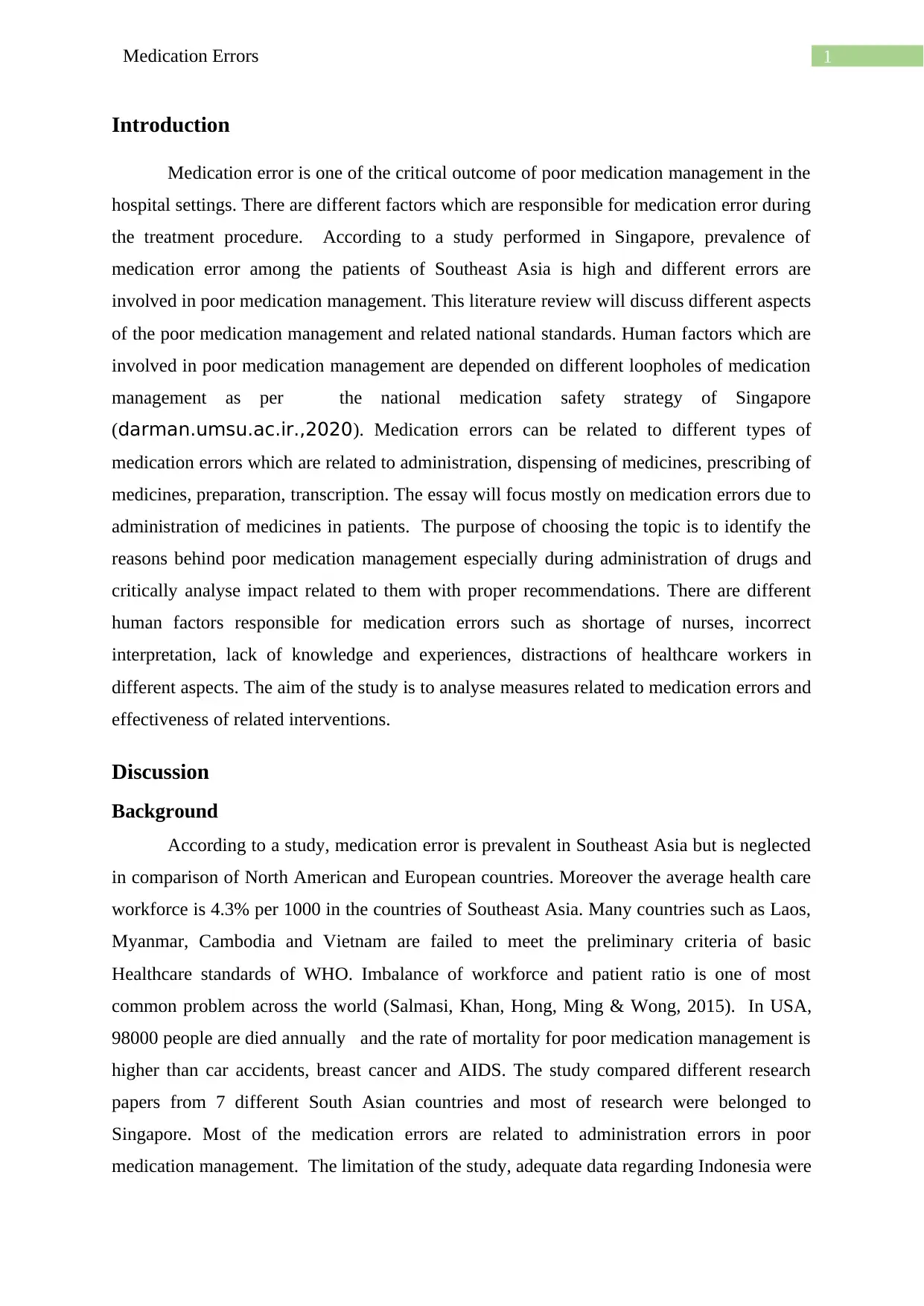
1Medication Errors
Introduction
Medication error is one of the critical outcome of poor medication management in the
hospital settings. There are different factors which are responsible for medication error during
the treatment procedure. According to a study performed in Singapore, prevalence of
medication error among the patients of Southeast Asia is high and different errors are
involved in poor medication management. This literature review will discuss different aspects
of the poor medication management and related national standards. Human factors which are
involved in poor medication management are depended on different loopholes of medication
management as per the national medication safety strategy of Singapore
(darman.umsu.ac.ir.,2020). Medication errors can be related to different types of
medication errors which are related to administration, dispensing of medicines, prescribing of
medicines, preparation, transcription. The essay will focus mostly on medication errors due to
administration of medicines in patients. The purpose of choosing the topic is to identify the
reasons behind poor medication management especially during administration of drugs and
critically analyse impact related to them with proper recommendations. There are different
human factors responsible for medication errors such as shortage of nurses, incorrect
interpretation, lack of knowledge and experiences, distractions of healthcare workers in
different aspects. The aim of the study is to analyse measures related to medication errors and
effectiveness of related interventions.
Discussion
Background
According to a study, medication error is prevalent in Southeast Asia but is neglected
in comparison of North American and European countries. Moreover the average health care
workforce is 4.3% per 1000 in the countries of Southeast Asia. Many countries such as Laos,
Myanmar, Cambodia and Vietnam are failed to meet the preliminary criteria of basic
Healthcare standards of WHO. Imbalance of workforce and patient ratio is one of most
common problem across the world (Salmasi, Khan, Hong, Ming & Wong, 2015). In USA,
98000 people are died annually and the rate of mortality for poor medication management is
higher than car accidents, breast cancer and AIDS. The study compared different research
papers from 7 different South Asian countries and most of research were belonged to
Singapore. Most of the medication errors are related to administration errors in poor
medication management. The limitation of the study, adequate data regarding Indonesia were
Introduction
Medication error is one of the critical outcome of poor medication management in the
hospital settings. There are different factors which are responsible for medication error during
the treatment procedure. According to a study performed in Singapore, prevalence of
medication error among the patients of Southeast Asia is high and different errors are
involved in poor medication management. This literature review will discuss different aspects
of the poor medication management and related national standards. Human factors which are
involved in poor medication management are depended on different loopholes of medication
management as per the national medication safety strategy of Singapore
(darman.umsu.ac.ir.,2020). Medication errors can be related to different types of
medication errors which are related to administration, dispensing of medicines, prescribing of
medicines, preparation, transcription. The essay will focus mostly on medication errors due to
administration of medicines in patients. The purpose of choosing the topic is to identify the
reasons behind poor medication management especially during administration of drugs and
critically analyse impact related to them with proper recommendations. There are different
human factors responsible for medication errors such as shortage of nurses, incorrect
interpretation, lack of knowledge and experiences, distractions of healthcare workers in
different aspects. The aim of the study is to analyse measures related to medication errors and
effectiveness of related interventions.
Discussion
Background
According to a study, medication error is prevalent in Southeast Asia but is neglected
in comparison of North American and European countries. Moreover the average health care
workforce is 4.3% per 1000 in the countries of Southeast Asia. Many countries such as Laos,
Myanmar, Cambodia and Vietnam are failed to meet the preliminary criteria of basic
Healthcare standards of WHO. Imbalance of workforce and patient ratio is one of most
common problem across the world (Salmasi, Khan, Hong, Ming & Wong, 2015). In USA,
98000 people are died annually and the rate of mortality for poor medication management is
higher than car accidents, breast cancer and AIDS. The study compared different research
papers from 7 different South Asian countries and most of research were belonged to
Singapore. Most of the medication errors are related to administration errors in poor
medication management. The limitation of the study, adequate data regarding Indonesia were
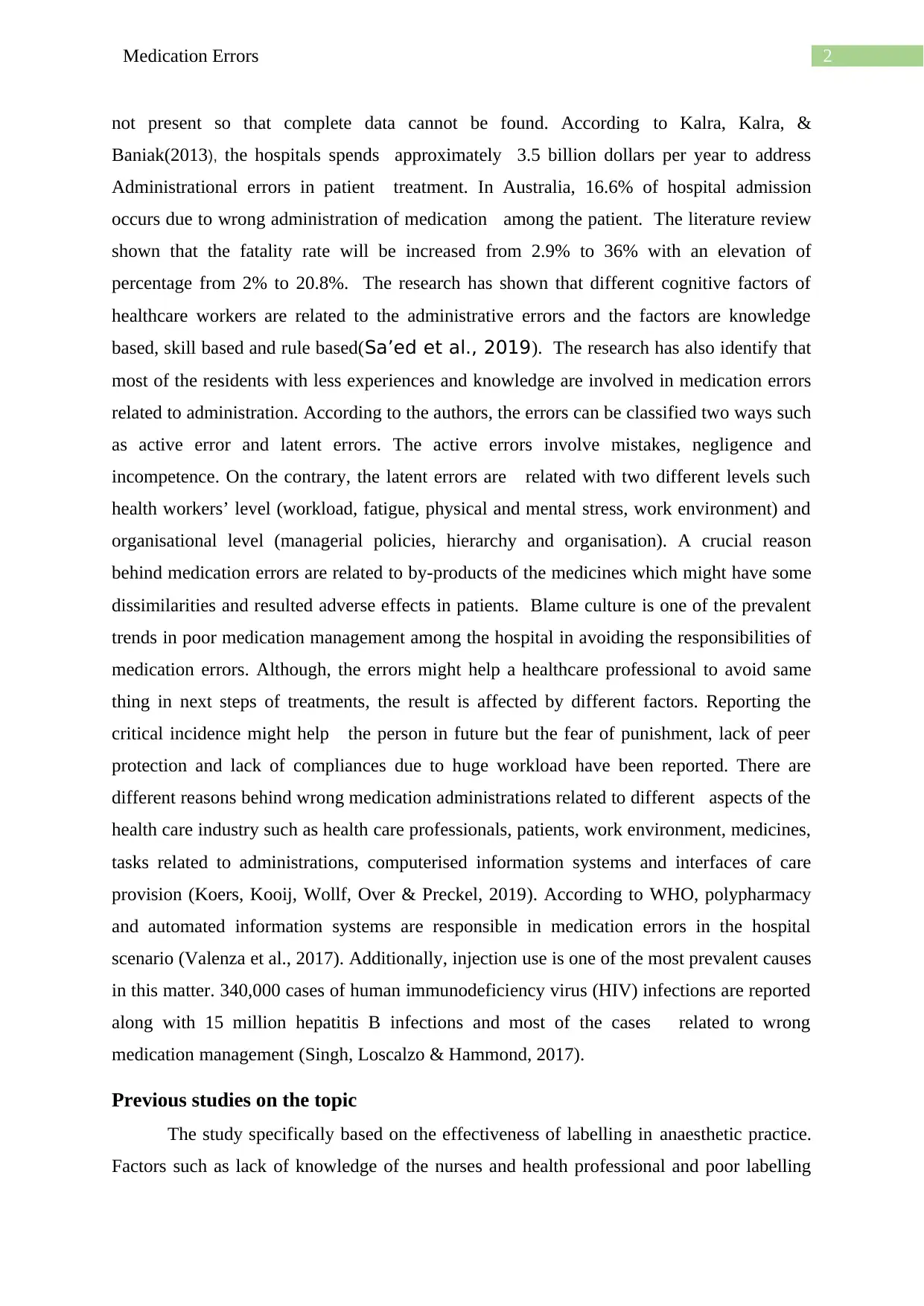
2Medication Errors
not present so that complete data cannot be found. According to Kalra, Kalra, &
Baniak(2013), the hospitals spends approximately 3.5 billion dollars per year to address
Administrational errors in patient treatment. In Australia, 16.6% of hospital admission
occurs due to wrong administration of medication among the patient. The literature review
shown that the fatality rate will be increased from 2.9% to 36% with an elevation of
percentage from 2% to 20.8%. The research has shown that different cognitive factors of
healthcare workers are related to the administrative errors and the factors are knowledge
based, skill based and rule based(Sa’ed et al., 2019). The research has also identify that
most of the residents with less experiences and knowledge are involved in medication errors
related to administration. According to the authors, the errors can be classified two ways such
as active error and latent errors. The active errors involve mistakes, negligence and
incompetence. On the contrary, the latent errors are related with two different levels such
health workers’ level (workload, fatigue, physical and mental stress, work environment) and
organisational level (managerial policies, hierarchy and organisation). A crucial reason
behind medication errors are related to by-products of the medicines which might have some
dissimilarities and resulted adverse effects in patients. Blame culture is one of the prevalent
trends in poor medication management among the hospital in avoiding the responsibilities of
medication errors. Although, the errors might help a healthcare professional to avoid same
thing in next steps of treatments, the result is affected by different factors. Reporting the
critical incidence might help the person in future but the fear of punishment, lack of peer
protection and lack of compliances due to huge workload have been reported. There are
different reasons behind wrong medication administrations related to different aspects of the
health care industry such as health care professionals, patients, work environment, medicines,
tasks related to administrations, computerised information systems and interfaces of care
provision (Koers, Kooij, Wollf, Over & Preckel, 2019). According to WHO, polypharmacy
and automated information systems are responsible in medication errors in the hospital
scenario (Valenza et al., 2017). Additionally, injection use is one of the most prevalent causes
in this matter. 340,000 cases of human immunodeficiency virus (HIV) infections are reported
along with 15 million hepatitis B infections and most of the cases related to wrong
medication management (Singh, Loscalzo & Hammond, 2017).
Previous studies on the topic
The study specifically based on the effectiveness of labelling in anaesthetic practice.
Factors such as lack of knowledge of the nurses and health professional and poor labelling
not present so that complete data cannot be found. According to Kalra, Kalra, &
Baniak(2013), the hospitals spends approximately 3.5 billion dollars per year to address
Administrational errors in patient treatment. In Australia, 16.6% of hospital admission
occurs due to wrong administration of medication among the patient. The literature review
shown that the fatality rate will be increased from 2.9% to 36% with an elevation of
percentage from 2% to 20.8%. The research has shown that different cognitive factors of
healthcare workers are related to the administrative errors and the factors are knowledge
based, skill based and rule based(Sa’ed et al., 2019). The research has also identify that
most of the residents with less experiences and knowledge are involved in medication errors
related to administration. According to the authors, the errors can be classified two ways such
as active error and latent errors. The active errors involve mistakes, negligence and
incompetence. On the contrary, the latent errors are related with two different levels such
health workers’ level (workload, fatigue, physical and mental stress, work environment) and
organisational level (managerial policies, hierarchy and organisation). A crucial reason
behind medication errors are related to by-products of the medicines which might have some
dissimilarities and resulted adverse effects in patients. Blame culture is one of the prevalent
trends in poor medication management among the hospital in avoiding the responsibilities of
medication errors. Although, the errors might help a healthcare professional to avoid same
thing in next steps of treatments, the result is affected by different factors. Reporting the
critical incidence might help the person in future but the fear of punishment, lack of peer
protection and lack of compliances due to huge workload have been reported. There are
different reasons behind wrong medication administrations related to different aspects of the
health care industry such as health care professionals, patients, work environment, medicines,
tasks related to administrations, computerised information systems and interfaces of care
provision (Koers, Kooij, Wollf, Over & Preckel, 2019). According to WHO, polypharmacy
and automated information systems are responsible in medication errors in the hospital
scenario (Valenza et al., 2017). Additionally, injection use is one of the most prevalent causes
in this matter. 340,000 cases of human immunodeficiency virus (HIV) infections are reported
along with 15 million hepatitis B infections and most of the cases related to wrong
medication management (Singh, Loscalzo & Hammond, 2017).
Previous studies on the topic
The study specifically based on the effectiveness of labelling in anaesthetic practice.
Factors such as lack of knowledge of the nurses and health professional and poor labelling
You're viewing a preview
Unlock full access by subscribing today!
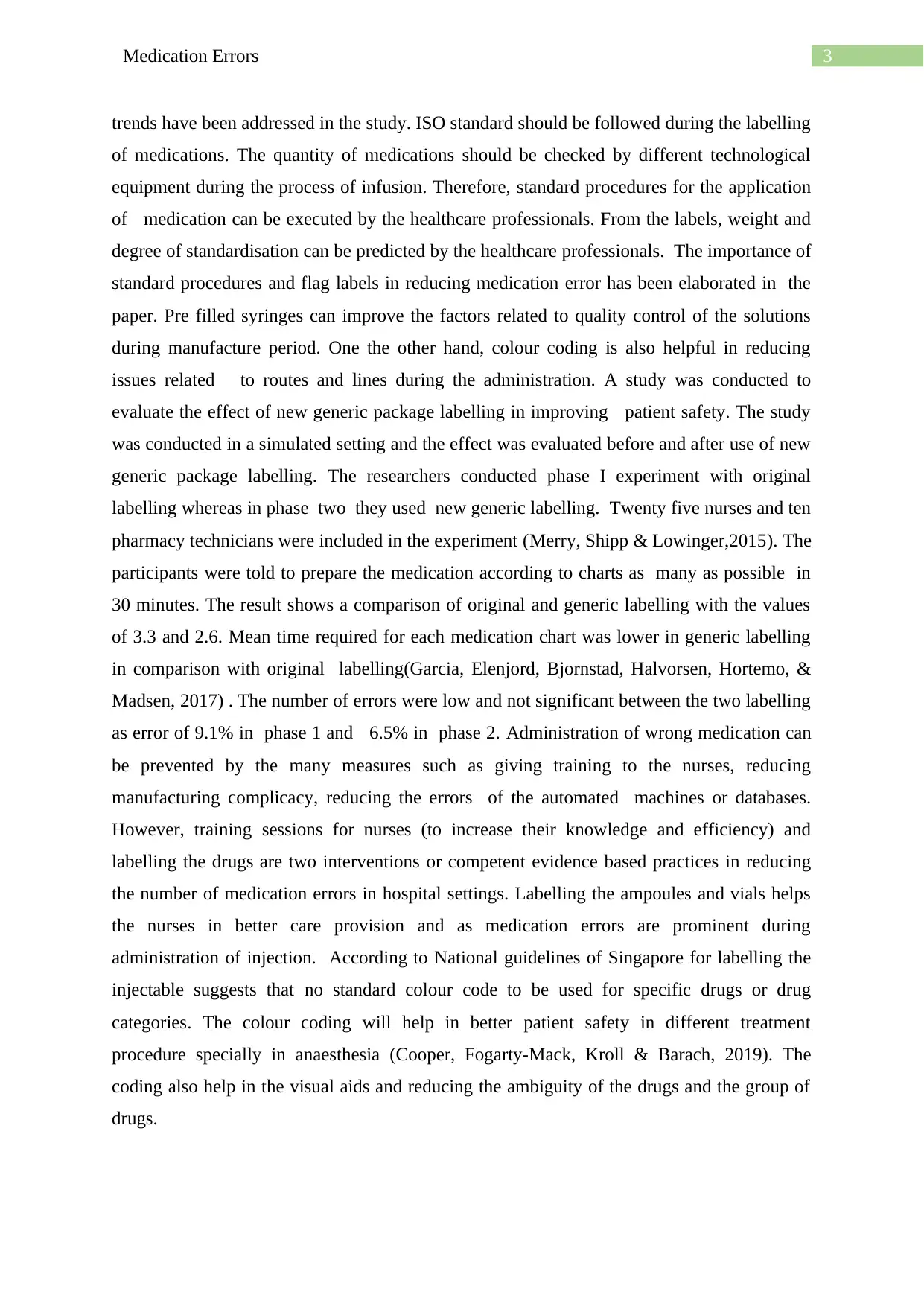
3Medication Errors
trends have been addressed in the study. ISO standard should be followed during the labelling
of medications. The quantity of medications should be checked by different technological
equipment during the process of infusion. Therefore, standard procedures for the application
of medication can be executed by the healthcare professionals. From the labels, weight and
degree of standardisation can be predicted by the healthcare professionals. The importance of
standard procedures and flag labels in reducing medication error has been elaborated in the
paper. Pre filled syringes can improve the factors related to quality control of the solutions
during manufacture period. One the other hand, colour coding is also helpful in reducing
issues related to routes and lines during the administration. A study was conducted to
evaluate the effect of new generic package labelling in improving patient safety. The study
was conducted in a simulated setting and the effect was evaluated before and after use of new
generic package labelling. The researchers conducted phase I experiment with original
labelling whereas in phase two they used new generic labelling. Twenty five nurses and ten
pharmacy technicians were included in the experiment (Merry, Shipp & Lowinger,2015). The
participants were told to prepare the medication according to charts as many as possible in
30 minutes. The result shows a comparison of original and generic labelling with the values
of 3.3 and 2.6. Mean time required for each medication chart was lower in generic labelling
in comparison with original labelling(Garcia, Elenjord, Bjornstad, Halvorsen, Hortemo, &
Madsen, 2017) . The number of errors were low and not significant between the two labelling
as error of 9.1% in phase 1 and 6.5% in phase 2. Administration of wrong medication can
be prevented by the many measures such as giving training to the nurses, reducing
manufacturing complicacy, reducing the errors of the automated machines or databases.
However, training sessions for nurses (to increase their knowledge and efficiency) and
labelling the drugs are two interventions or competent evidence based practices in reducing
the number of medication errors in hospital settings. Labelling the ampoules and vials helps
the nurses in better care provision and as medication errors are prominent during
administration of injection. According to National guidelines of Singapore for labelling the
injectable suggests that no standard colour code to be used for specific drugs or drug
categories. The colour coding will help in better patient safety in different treatment
procedure specially in anaesthesia (Cooper, Fogarty-Mack, Kroll & Barach, 2019). The
coding also help in the visual aids and reducing the ambiguity of the drugs and the group of
drugs.
trends have been addressed in the study. ISO standard should be followed during the labelling
of medications. The quantity of medications should be checked by different technological
equipment during the process of infusion. Therefore, standard procedures for the application
of medication can be executed by the healthcare professionals. From the labels, weight and
degree of standardisation can be predicted by the healthcare professionals. The importance of
standard procedures and flag labels in reducing medication error has been elaborated in the
paper. Pre filled syringes can improve the factors related to quality control of the solutions
during manufacture period. One the other hand, colour coding is also helpful in reducing
issues related to routes and lines during the administration. A study was conducted to
evaluate the effect of new generic package labelling in improving patient safety. The study
was conducted in a simulated setting and the effect was evaluated before and after use of new
generic package labelling. The researchers conducted phase I experiment with original
labelling whereas in phase two they used new generic labelling. Twenty five nurses and ten
pharmacy technicians were included in the experiment (Merry, Shipp & Lowinger,2015). The
participants were told to prepare the medication according to charts as many as possible in
30 minutes. The result shows a comparison of original and generic labelling with the values
of 3.3 and 2.6. Mean time required for each medication chart was lower in generic labelling
in comparison with original labelling(Garcia, Elenjord, Bjornstad, Halvorsen, Hortemo, &
Madsen, 2017) . The number of errors were low and not significant between the two labelling
as error of 9.1% in phase 1 and 6.5% in phase 2. Administration of wrong medication can
be prevented by the many measures such as giving training to the nurses, reducing
manufacturing complicacy, reducing the errors of the automated machines or databases.
However, training sessions for nurses (to increase their knowledge and efficiency) and
labelling the drugs are two interventions or competent evidence based practices in reducing
the number of medication errors in hospital settings. Labelling the ampoules and vials helps
the nurses in better care provision and as medication errors are prominent during
administration of injection. According to National guidelines of Singapore for labelling the
injectable suggests that no standard colour code to be used for specific drugs or drug
categories. The colour coding will help in better patient safety in different treatment
procedure specially in anaesthesia (Cooper, Fogarty-Mack, Kroll & Barach, 2019). The
coding also help in the visual aids and reducing the ambiguity of the drugs and the group of
drugs.
Paraphrase This Document
Need a fresh take? Get an instant paraphrase of this document with our AI Paraphraser
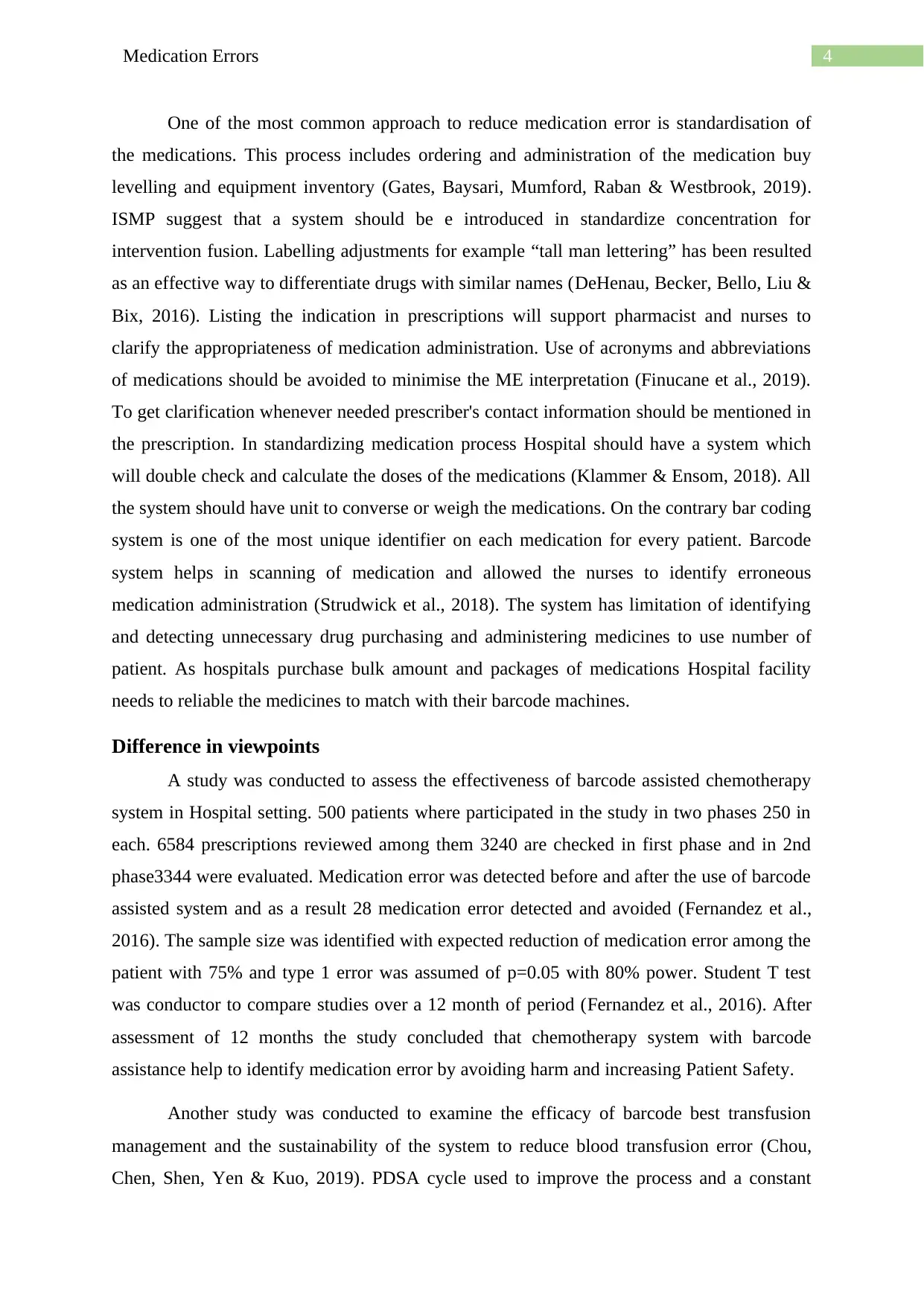
4Medication Errors
One of the most common approach to reduce medication error is standardisation of
the medications. This process includes ordering and administration of the medication buy
levelling and equipment inventory (Gates, Baysari, Mumford, Raban & Westbrook, 2019).
ISMP suggest that a system should be e introduced in standardize concentration for
intervention fusion. Labelling adjustments for example “tall man lettering” has been resulted
as an effective way to differentiate drugs with similar names (DeHenau, Becker, Bello, Liu &
Bix, 2016). Listing the indication in prescriptions will support pharmacist and nurses to
clarify the appropriateness of medication administration. Use of acronyms and abbreviations
of medications should be avoided to minimise the ME interpretation (Finucane et al., 2019).
To get clarification whenever needed prescriber's contact information should be mentioned in
the prescription. In standardizing medication process Hospital should have a system which
will double check and calculate the doses of the medications (Klammer & Ensom, 2018). All
the system should have unit to converse or weigh the medications. On the contrary bar coding
system is one of the most unique identifier on each medication for every patient. Barcode
system helps in scanning of medication and allowed the nurses to identify erroneous
medication administration (Strudwick et al., 2018). The system has limitation of identifying
and detecting unnecessary drug purchasing and administering medicines to use number of
patient. As hospitals purchase bulk amount and packages of medications Hospital facility
needs to reliable the medicines to match with their barcode machines.
Difference in viewpoints
A study was conducted to assess the effectiveness of barcode assisted chemotherapy
system in Hospital setting. 500 patients where participated in the study in two phases 250 in
each. 6584 prescriptions reviewed among them 3240 are checked in first phase and in 2nd
phase3344 were evaluated. Medication error was detected before and after the use of barcode
assisted system and as a result 28 medication error detected and avoided (Fernandez et al.,
2016). The sample size was identified with expected reduction of medication error among the
patient with 75% and type 1 error was assumed of p=0.05 with 80% power. Student T test
was conductor to compare studies over a 12 month of period (Fernandez et al., 2016). After
assessment of 12 months the study concluded that chemotherapy system with barcode
assistance help to identify medication error by avoiding harm and increasing Patient Safety.
Another study was conducted to examine the efficacy of barcode best transfusion
management and the sustainability of the system to reduce blood transfusion error (Chou,
Chen, Shen, Yen & Kuo, 2019). PDSA cycle used to improve the process and a constant
One of the most common approach to reduce medication error is standardisation of
the medications. This process includes ordering and administration of the medication buy
levelling and equipment inventory (Gates, Baysari, Mumford, Raban & Westbrook, 2019).
ISMP suggest that a system should be e introduced in standardize concentration for
intervention fusion. Labelling adjustments for example “tall man lettering” has been resulted
as an effective way to differentiate drugs with similar names (DeHenau, Becker, Bello, Liu &
Bix, 2016). Listing the indication in prescriptions will support pharmacist and nurses to
clarify the appropriateness of medication administration. Use of acronyms and abbreviations
of medications should be avoided to minimise the ME interpretation (Finucane et al., 2019).
To get clarification whenever needed prescriber's contact information should be mentioned in
the prescription. In standardizing medication process Hospital should have a system which
will double check and calculate the doses of the medications (Klammer & Ensom, 2018). All
the system should have unit to converse or weigh the medications. On the contrary bar coding
system is one of the most unique identifier on each medication for every patient. Barcode
system helps in scanning of medication and allowed the nurses to identify erroneous
medication administration (Strudwick et al., 2018). The system has limitation of identifying
and detecting unnecessary drug purchasing and administering medicines to use number of
patient. As hospitals purchase bulk amount and packages of medications Hospital facility
needs to reliable the medicines to match with their barcode machines.
Difference in viewpoints
A study was conducted to assess the effectiveness of barcode assisted chemotherapy
system in Hospital setting. 500 patients where participated in the study in two phases 250 in
each. 6584 prescriptions reviewed among them 3240 are checked in first phase and in 2nd
phase3344 were evaluated. Medication error was detected before and after the use of barcode
assisted system and as a result 28 medication error detected and avoided (Fernandez et al.,
2016). The sample size was identified with expected reduction of medication error among the
patient with 75% and type 1 error was assumed of p=0.05 with 80% power. Student T test
was conductor to compare studies over a 12 month of period (Fernandez et al., 2016). After
assessment of 12 months the study concluded that chemotherapy system with barcode
assistance help to identify medication error by avoiding harm and increasing Patient Safety.
Another study was conducted to examine the efficacy of barcode best transfusion
management and the sustainability of the system to reduce blood transfusion error (Chou,
Chen, Shen, Yen & Kuo, 2019). PDSA cycle used to improve the process and a constant
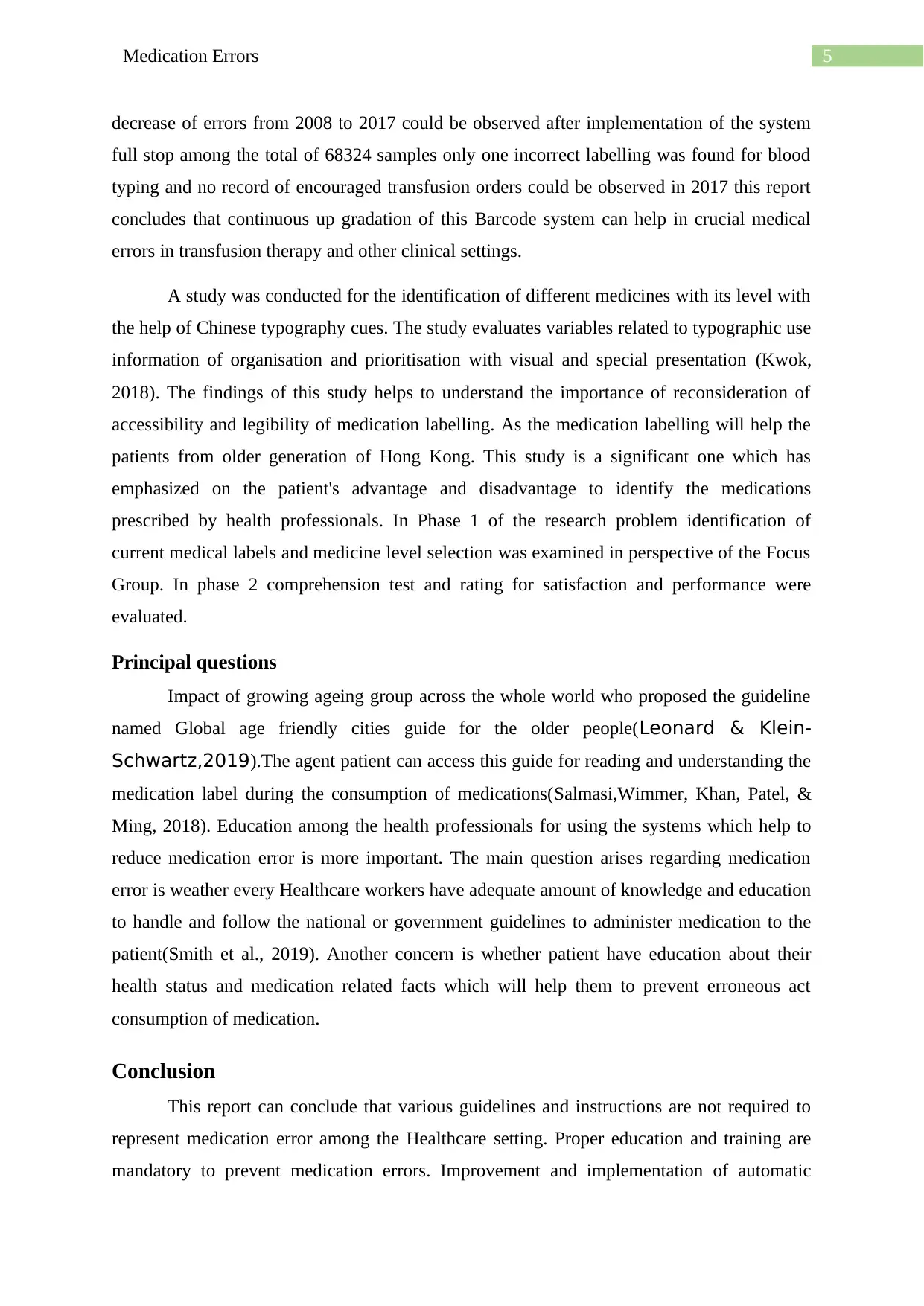
5Medication Errors
decrease of errors from 2008 to 2017 could be observed after implementation of the system
full stop among the total of 68324 samples only one incorrect labelling was found for blood
typing and no record of encouraged transfusion orders could be observed in 2017 this report
concludes that continuous up gradation of this Barcode system can help in crucial medical
errors in transfusion therapy and other clinical settings.
A study was conducted for the identification of different medicines with its level with
the help of Chinese typography cues. The study evaluates variables related to typographic use
information of organisation and prioritisation with visual and special presentation (Kwok,
2018). The findings of this study helps to understand the importance of reconsideration of
accessibility and legibility of medication labelling. As the medication labelling will help the
patients from older generation of Hong Kong. This study is a significant one which has
emphasized on the patient's advantage and disadvantage to identify the medications
prescribed by health professionals. In Phase 1 of the research problem identification of
current medical labels and medicine level selection was examined in perspective of the Focus
Group. In phase 2 comprehension test and rating for satisfaction and performance were
evaluated.
Principal questions
Impact of growing ageing group across the whole world who proposed the guideline
named Global age friendly cities guide for the older people(Leonard & Klein-
Schwartz,2019).The agent patient can access this guide for reading and understanding the
medication label during the consumption of medications(Salmasi,Wimmer, Khan, Patel, &
Ming, 2018). Education among the health professionals for using the systems which help to
reduce medication error is more important. The main question arises regarding medication
error is weather every Healthcare workers have adequate amount of knowledge and education
to handle and follow the national or government guidelines to administer medication to the
patient(Smith et al., 2019). Another concern is whether patient have education about their
health status and medication related facts which will help them to prevent erroneous act
consumption of medication.
Conclusion
This report can conclude that various guidelines and instructions are not required to
represent medication error among the Healthcare setting. Proper education and training are
mandatory to prevent medication errors. Improvement and implementation of automatic
decrease of errors from 2008 to 2017 could be observed after implementation of the system
full stop among the total of 68324 samples only one incorrect labelling was found for blood
typing and no record of encouraged transfusion orders could be observed in 2017 this report
concludes that continuous up gradation of this Barcode system can help in crucial medical
errors in transfusion therapy and other clinical settings.
A study was conducted for the identification of different medicines with its level with
the help of Chinese typography cues. The study evaluates variables related to typographic use
information of organisation and prioritisation with visual and special presentation (Kwok,
2018). The findings of this study helps to understand the importance of reconsideration of
accessibility and legibility of medication labelling. As the medication labelling will help the
patients from older generation of Hong Kong. This study is a significant one which has
emphasized on the patient's advantage and disadvantage to identify the medications
prescribed by health professionals. In Phase 1 of the research problem identification of
current medical labels and medicine level selection was examined in perspective of the Focus
Group. In phase 2 comprehension test and rating for satisfaction and performance were
evaluated.
Principal questions
Impact of growing ageing group across the whole world who proposed the guideline
named Global age friendly cities guide for the older people(Leonard & Klein-
Schwartz,2019).The agent patient can access this guide for reading and understanding the
medication label during the consumption of medications(Salmasi,Wimmer, Khan, Patel, &
Ming, 2018). Education among the health professionals for using the systems which help to
reduce medication error is more important. The main question arises regarding medication
error is weather every Healthcare workers have adequate amount of knowledge and education
to handle and follow the national or government guidelines to administer medication to the
patient(Smith et al., 2019). Another concern is whether patient have education about their
health status and medication related facts which will help them to prevent erroneous act
consumption of medication.
Conclusion
This report can conclude that various guidelines and instructions are not required to
represent medication error among the Healthcare setting. Proper education and training are
mandatory to prevent medication errors. Improvement and implementation of automatic
You're viewing a preview
Unlock full access by subscribing today!
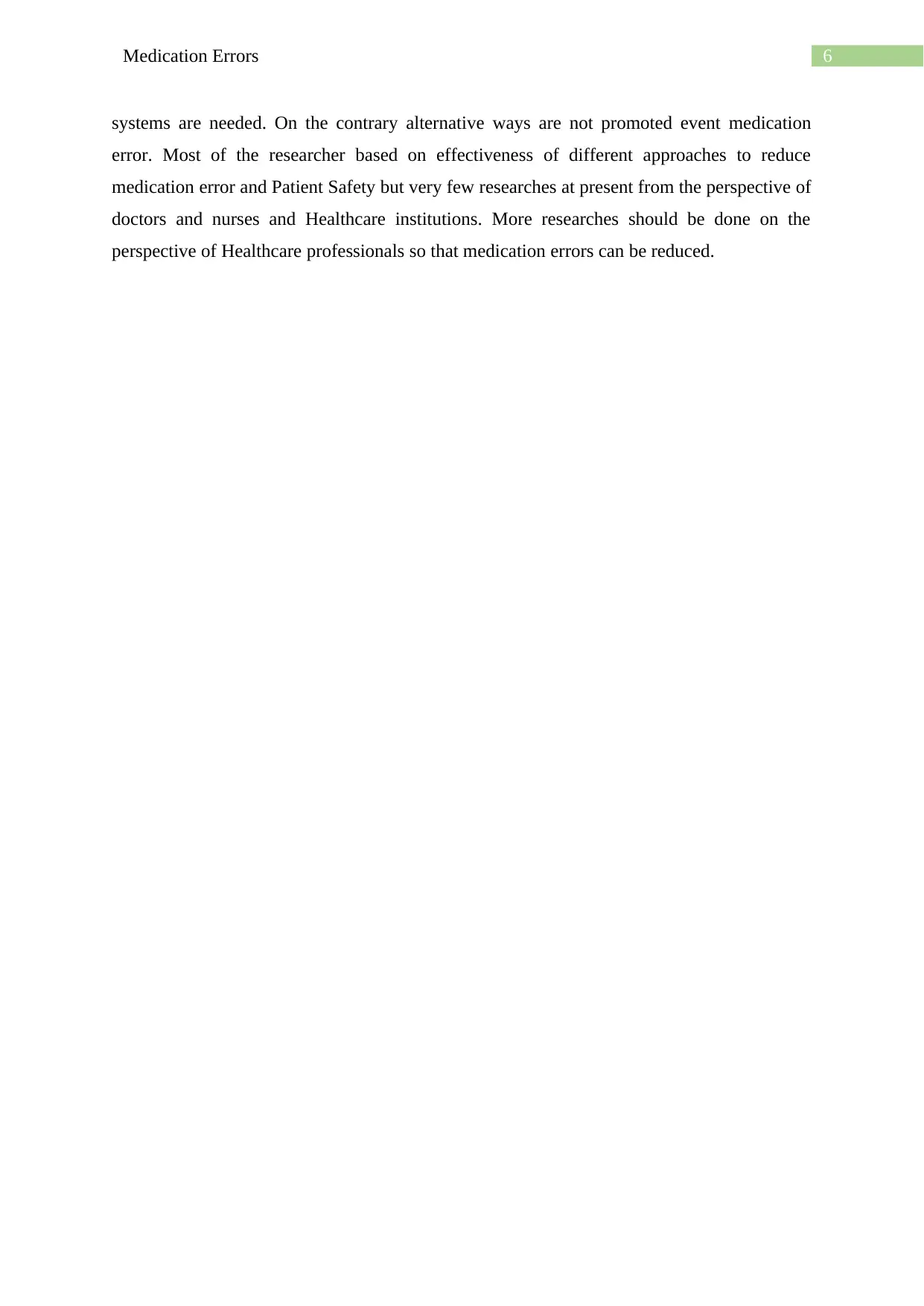
6Medication Errors
systems are needed. On the contrary alternative ways are not promoted event medication
error. Most of the researcher based on effectiveness of different approaches to reduce
medication error and Patient Safety but very few researches at present from the perspective of
doctors and nurses and Healthcare institutions. More researches should be done on the
perspective of Healthcare professionals so that medication errors can be reduced.
systems are needed. On the contrary alternative ways are not promoted event medication
error. Most of the researcher based on effectiveness of different approaches to reduce
medication error and Patient Safety but very few researches at present from the perspective of
doctors and nurses and Healthcare institutions. More researches should be done on the
perspective of Healthcare professionals so that medication errors can be reduced.
Paraphrase This Document
Need a fresh take? Get an instant paraphrase of this document with our AI Paraphraser
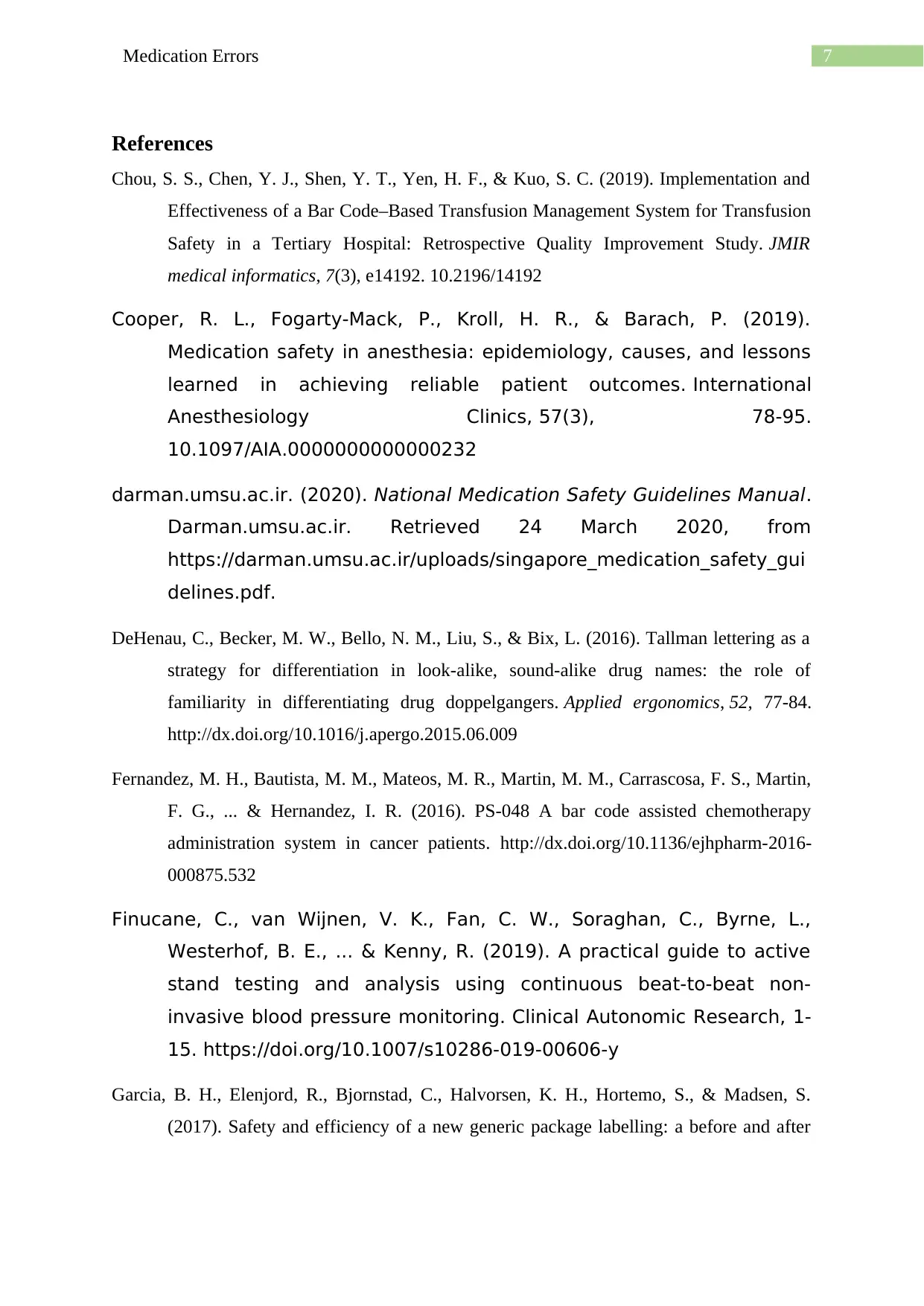
7Medication Errors
References
Chou, S. S., Chen, Y. J., Shen, Y. T., Yen, H. F., & Kuo, S. C. (2019). Implementation and
Effectiveness of a Bar Code–Based Transfusion Management System for Transfusion
Safety in a Tertiary Hospital: Retrospective Quality Improvement Study. JMIR
medical informatics, 7(3), e14192. 10.2196/14192
Cooper, R. L., Fogarty-Mack, P., Kroll, H. R., & Barach, P. (2019).
Medication safety in anesthesia: epidemiology, causes, and lessons
learned in achieving reliable patient outcomes. International
Anesthesiology Clinics, 57(3), 78-95.
10.1097/AIA.0000000000000232
darman.umsu.ac.ir. (2020). National Medication Safety Guidelines Manual.
Darman.umsu.ac.ir. Retrieved 24 March 2020, from
https://darman.umsu.ac.ir/uploads/singapore_medication_safety_gui
delines.pdf.
DeHenau, C., Becker, M. W., Bello, N. M., Liu, S., & Bix, L. (2016). Tallman lettering as a
strategy for differentiation in look-alike, sound-alike drug names: the role of
familiarity in differentiating drug doppelgangers. Applied ergonomics, 52, 77-84.
http://dx.doi.org/10.1016/j.apergo.2015.06.009
Fernandez, M. H., Bautista, M. M., Mateos, M. R., Martin, M. M., Carrascosa, F. S., Martin,
F. G., ... & Hernandez, I. R. (2016). PS-048 A bar code assisted chemotherapy
administration system in cancer patients. http://dx.doi.org/10.1136/ejhpharm-2016-
000875.532
Finucane, C., van Wijnen, V. K., Fan, C. W., Soraghan, C., Byrne, L.,
Westerhof, B. E., ... & Kenny, R. (2019). A practical guide to active
stand testing and analysis using continuous beat-to-beat non-
invasive blood pressure monitoring. Clinical Autonomic Research, 1-
15. https://doi.org/10.1007/s10286-019-00606-y
Garcia, B. H., Elenjord, R., Bjornstad, C., Halvorsen, K. H., Hortemo, S., & Madsen, S.
(2017). Safety and efficiency of a new generic package labelling: a before and after
References
Chou, S. S., Chen, Y. J., Shen, Y. T., Yen, H. F., & Kuo, S. C. (2019). Implementation and
Effectiveness of a Bar Code–Based Transfusion Management System for Transfusion
Safety in a Tertiary Hospital: Retrospective Quality Improvement Study. JMIR
medical informatics, 7(3), e14192. 10.2196/14192
Cooper, R. L., Fogarty-Mack, P., Kroll, H. R., & Barach, P. (2019).
Medication safety in anesthesia: epidemiology, causes, and lessons
learned in achieving reliable patient outcomes. International
Anesthesiology Clinics, 57(3), 78-95.
10.1097/AIA.0000000000000232
darman.umsu.ac.ir. (2020). National Medication Safety Guidelines Manual.
Darman.umsu.ac.ir. Retrieved 24 March 2020, from
https://darman.umsu.ac.ir/uploads/singapore_medication_safety_gui
delines.pdf.
DeHenau, C., Becker, M. W., Bello, N. M., Liu, S., & Bix, L. (2016). Tallman lettering as a
strategy for differentiation in look-alike, sound-alike drug names: the role of
familiarity in differentiating drug doppelgangers. Applied ergonomics, 52, 77-84.
http://dx.doi.org/10.1016/j.apergo.2015.06.009
Fernandez, M. H., Bautista, M. M., Mateos, M. R., Martin, M. M., Carrascosa, F. S., Martin,
F. G., ... & Hernandez, I. R. (2016). PS-048 A bar code assisted chemotherapy
administration system in cancer patients. http://dx.doi.org/10.1136/ejhpharm-2016-
000875.532
Finucane, C., van Wijnen, V. K., Fan, C. W., Soraghan, C., Byrne, L.,
Westerhof, B. E., ... & Kenny, R. (2019). A practical guide to active
stand testing and analysis using continuous beat-to-beat non-
invasive blood pressure monitoring. Clinical Autonomic Research, 1-
15. https://doi.org/10.1007/s10286-019-00606-y
Garcia, B. H., Elenjord, R., Bjornstad, C., Halvorsen, K. H., Hortemo, S., & Madsen, S.
(2017). Safety and efficiency of a new generic package labelling: a before and after
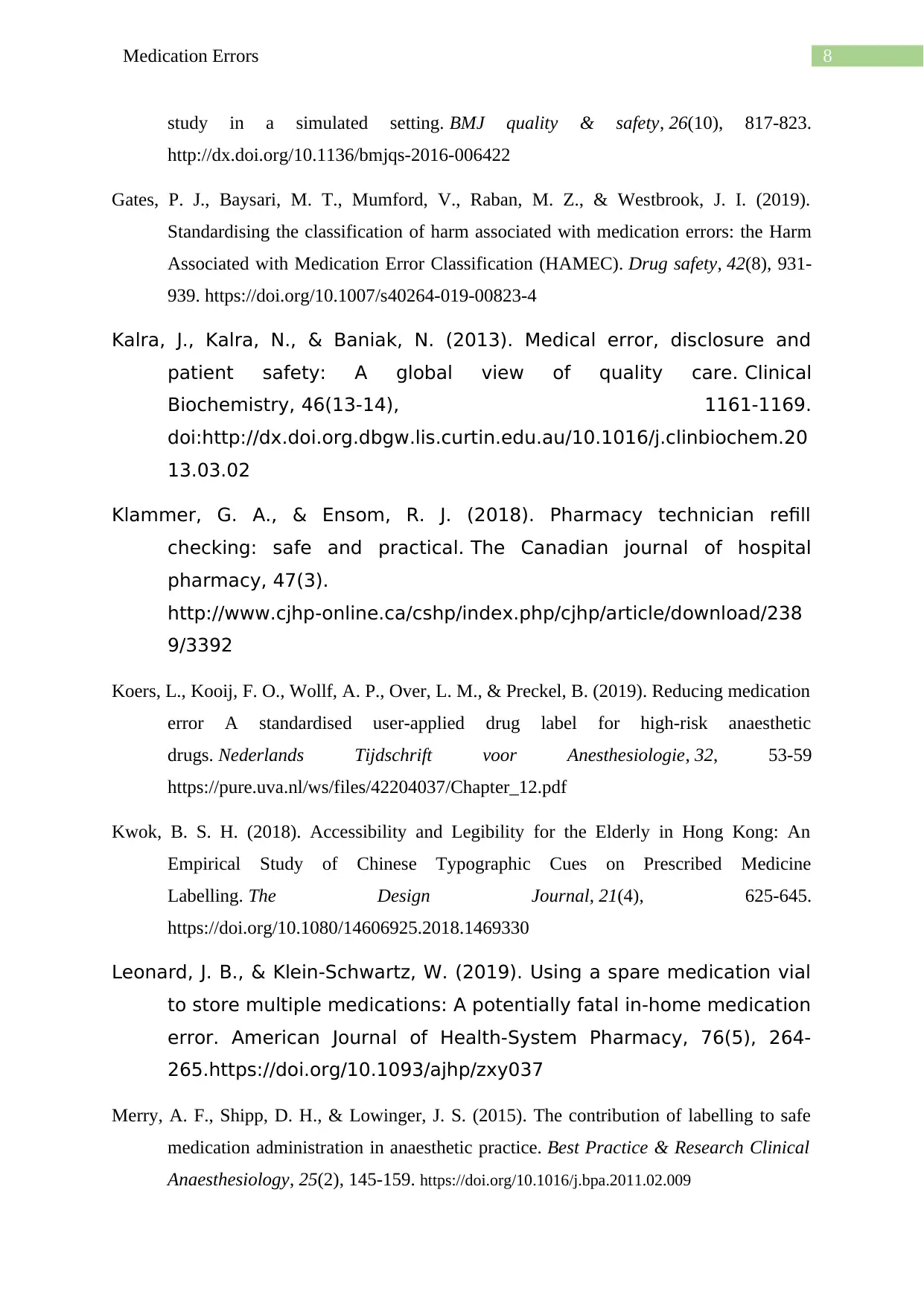
8Medication Errors
study in a simulated setting. BMJ quality & safety, 26(10), 817-823.
http://dx.doi.org/10.1136/bmjqs-2016-006422
Gates, P. J., Baysari, M. T., Mumford, V., Raban, M. Z., & Westbrook, J. I. (2019).
Standardising the classification of harm associated with medication errors: the Harm
Associated with Medication Error Classification (HAMEC). Drug safety, 42(8), 931-
939. https://doi.org/10.1007/s40264-019-00823-4
Kalra, J., Kalra, N., & Baniak, N. (2013). Medical error, disclosure and
patient safety: A global view of quality care. Clinical
Biochemistry, 46(13-14), 1161-1169.
doi:http://dx.doi.org.dbgw.lis.curtin.edu.au/10.1016/j.clinbiochem.20
13.03.02
Klammer, G. A., & Ensom, R. J. (2018). Pharmacy technician refill
checking: safe and practical. The Canadian journal of hospital
pharmacy, 47(3).
http://www.cjhp-online.ca/cshp/index.php/cjhp/article/download/238
9/3392
Koers, L., Kooij, F. O., Wollf, A. P., Over, L. M., & Preckel, B. (2019). Reducing medication
error A standardised user-applied drug label for high-risk anaesthetic
drugs. Nederlands Tijdschrift voor Anesthesiologie, 32, 53-59
https://pure.uva.nl/ws/files/42204037/Chapter_12.pdf
Kwok, B. S. H. (2018). Accessibility and Legibility for the Elderly in Hong Kong: An
Empirical Study of Chinese Typographic Cues on Prescribed Medicine
Labelling. The Design Journal, 21(4), 625-645.
https://doi.org/10.1080/14606925.2018.1469330
Leonard, J. B., & Klein-Schwartz, W. (2019). Using a spare medication vial
to store multiple medications: A potentially fatal in-home medication
error. American Journal of Health-System Pharmacy, 76(5), 264-
265.https://doi.org/10.1093/ajhp/zxy037
Merry, A. F., Shipp, D. H., & Lowinger, J. S. (2015). The contribution of labelling to safe
medication administration in anaesthetic practice. Best Practice & Research Clinical
Anaesthesiology, 25(2), 145-159. https://doi.org/10.1016/j.bpa.2011.02.009
study in a simulated setting. BMJ quality & safety, 26(10), 817-823.
http://dx.doi.org/10.1136/bmjqs-2016-006422
Gates, P. J., Baysari, M. T., Mumford, V., Raban, M. Z., & Westbrook, J. I. (2019).
Standardising the classification of harm associated with medication errors: the Harm
Associated with Medication Error Classification (HAMEC). Drug safety, 42(8), 931-
939. https://doi.org/10.1007/s40264-019-00823-4
Kalra, J., Kalra, N., & Baniak, N. (2013). Medical error, disclosure and
patient safety: A global view of quality care. Clinical
Biochemistry, 46(13-14), 1161-1169.
doi:http://dx.doi.org.dbgw.lis.curtin.edu.au/10.1016/j.clinbiochem.20
13.03.02
Klammer, G. A., & Ensom, R. J. (2018). Pharmacy technician refill
checking: safe and practical. The Canadian journal of hospital
pharmacy, 47(3).
http://www.cjhp-online.ca/cshp/index.php/cjhp/article/download/238
9/3392
Koers, L., Kooij, F. O., Wollf, A. P., Over, L. M., & Preckel, B. (2019). Reducing medication
error A standardised user-applied drug label for high-risk anaesthetic
drugs. Nederlands Tijdschrift voor Anesthesiologie, 32, 53-59
https://pure.uva.nl/ws/files/42204037/Chapter_12.pdf
Kwok, B. S. H. (2018). Accessibility and Legibility for the Elderly in Hong Kong: An
Empirical Study of Chinese Typographic Cues on Prescribed Medicine
Labelling. The Design Journal, 21(4), 625-645.
https://doi.org/10.1080/14606925.2018.1469330
Leonard, J. B., & Klein-Schwartz, W. (2019). Using a spare medication vial
to store multiple medications: A potentially fatal in-home medication
error. American Journal of Health-System Pharmacy, 76(5), 264-
265.https://doi.org/10.1093/ajhp/zxy037
Merry, A. F., Shipp, D. H., & Lowinger, J. S. (2015). The contribution of labelling to safe
medication administration in anaesthetic practice. Best Practice & Research Clinical
Anaesthesiology, 25(2), 145-159. https://doi.org/10.1016/j.bpa.2011.02.009
You're viewing a preview
Unlock full access by subscribing today!
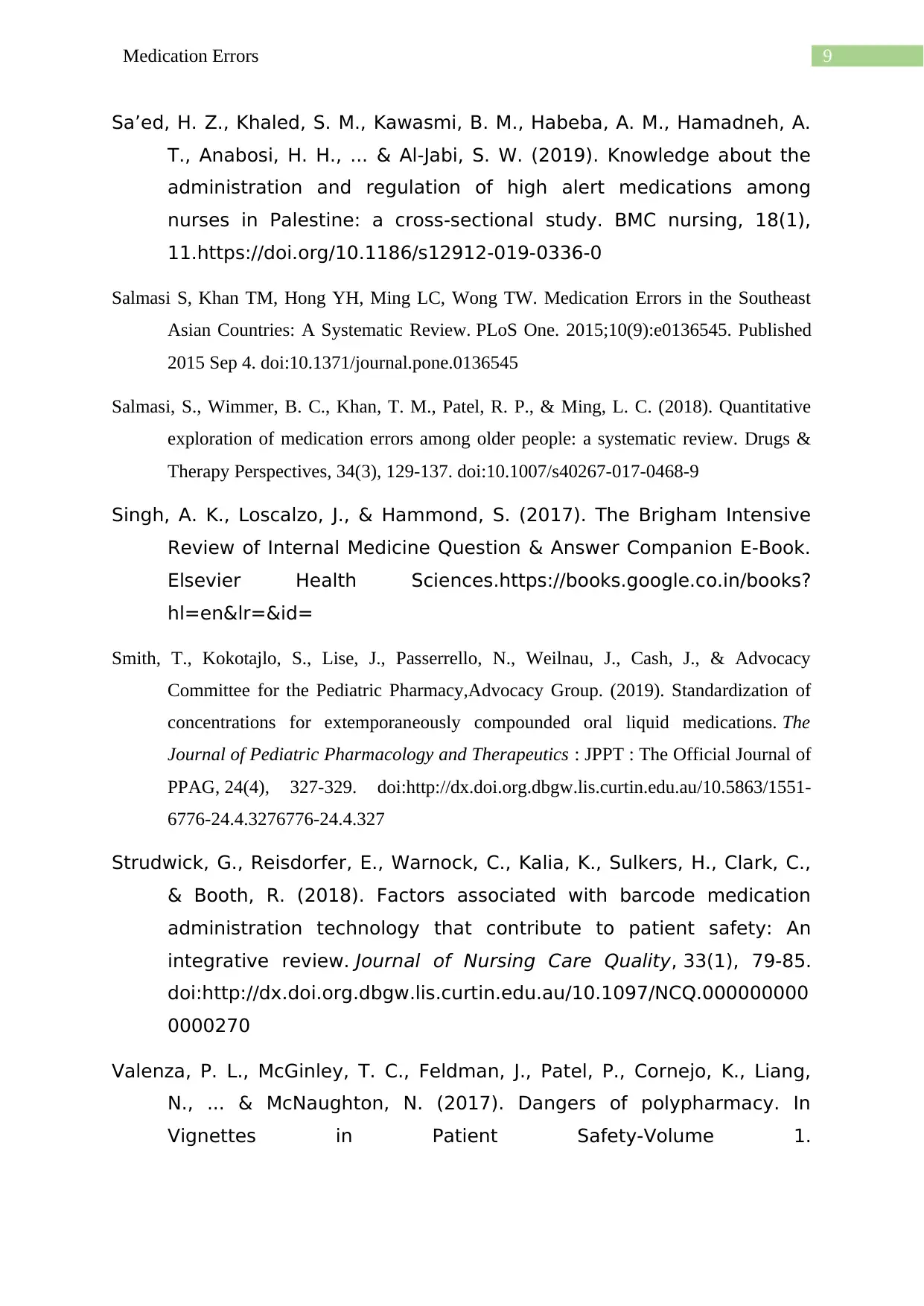
9Medication Errors
Sa’ed, H. Z., Khaled, S. M., Kawasmi, B. M., Habeba, A. M., Hamadneh, A.
T., Anabosi, H. H., ... & Al-Jabi, S. W. (2019). Knowledge about the
administration and regulation of high alert medications among
nurses in Palestine: a cross-sectional study. BMC nursing, 18(1),
11.https://doi.org/10.1186/s12912-019-0336-0
Salmasi S, Khan TM, Hong YH, Ming LC, Wong TW. Medication Errors in the Southeast
Asian Countries: A Systematic Review. PLoS One. 2015;10(9):e0136545. Published
2015 Sep 4. doi:10.1371/journal.pone.0136545
Salmasi, S., Wimmer, B. C., Khan, T. M., Patel, R. P., & Ming, L. C. (2018). Quantitative
exploration of medication errors among older people: a systematic review. Drugs &
Therapy Perspectives, 34(3), 129-137. doi:10.1007/s40267-017-0468-9
Singh, A. K., Loscalzo, J., & Hammond, S. (2017). The Brigham Intensive
Review of Internal Medicine Question & Answer Companion E-Book.
Elsevier Health Sciences.https://books.google.co.in/books?
hl=en&lr=&id=
Smith, T., Kokotajlo, S., Lise, J., Passerrello, N., Weilnau, J., Cash, J., & Advocacy
Committee for the Pediatric Pharmacy,Advocacy Group. (2019). Standardization of
concentrations for extemporaneously compounded oral liquid medications. The
Journal of Pediatric Pharmacology and Therapeutics : JPPT : The Official Journal of
PPAG, 24(4), 327-329. doi:http://dx.doi.org.dbgw.lis.curtin.edu.au/10.5863/1551-
6776-24.4.3276776-24.4.327
Strudwick, G., Reisdorfer, E., Warnock, C., Kalia, K., Sulkers, H., Clark, C.,
& Booth, R. (2018). Factors associated with barcode medication
administration technology that contribute to patient safety: An
integrative review. Journal of Nursing Care Quality, 33(1), 79-85.
doi:http://dx.doi.org.dbgw.lis.curtin.edu.au/10.1097/NCQ.000000000
0000270
Valenza, P. L., McGinley, T. C., Feldman, J., Patel, P., Cornejo, K., Liang,
N., ... & McNaughton, N. (2017). Dangers of polypharmacy. In
Vignettes in Patient Safety-Volume 1.
Sa’ed, H. Z., Khaled, S. M., Kawasmi, B. M., Habeba, A. M., Hamadneh, A.
T., Anabosi, H. H., ... & Al-Jabi, S. W. (2019). Knowledge about the
administration and regulation of high alert medications among
nurses in Palestine: a cross-sectional study. BMC nursing, 18(1),
11.https://doi.org/10.1186/s12912-019-0336-0
Salmasi S, Khan TM, Hong YH, Ming LC, Wong TW. Medication Errors in the Southeast
Asian Countries: A Systematic Review. PLoS One. 2015;10(9):e0136545. Published
2015 Sep 4. doi:10.1371/journal.pone.0136545
Salmasi, S., Wimmer, B. C., Khan, T. M., Patel, R. P., & Ming, L. C. (2018). Quantitative
exploration of medication errors among older people: a systematic review. Drugs &
Therapy Perspectives, 34(3), 129-137. doi:10.1007/s40267-017-0468-9
Singh, A. K., Loscalzo, J., & Hammond, S. (2017). The Brigham Intensive
Review of Internal Medicine Question & Answer Companion E-Book.
Elsevier Health Sciences.https://books.google.co.in/books?
hl=en&lr=&id=
Smith, T., Kokotajlo, S., Lise, J., Passerrello, N., Weilnau, J., Cash, J., & Advocacy
Committee for the Pediatric Pharmacy,Advocacy Group. (2019). Standardization of
concentrations for extemporaneously compounded oral liquid medications. The
Journal of Pediatric Pharmacology and Therapeutics : JPPT : The Official Journal of
PPAG, 24(4), 327-329. doi:http://dx.doi.org.dbgw.lis.curtin.edu.au/10.5863/1551-
6776-24.4.3276776-24.4.327
Strudwick, G., Reisdorfer, E., Warnock, C., Kalia, K., Sulkers, H., Clark, C.,
& Booth, R. (2018). Factors associated with barcode medication
administration technology that contribute to patient safety: An
integrative review. Journal of Nursing Care Quality, 33(1), 79-85.
doi:http://dx.doi.org.dbgw.lis.curtin.edu.au/10.1097/NCQ.000000000
0000270
Valenza, P. L., McGinley, T. C., Feldman, J., Patel, P., Cornejo, K., Liang,
N., ... & McNaughton, N. (2017). Dangers of polypharmacy. In
Vignettes in Patient Safety-Volume 1.
Paraphrase This Document
Need a fresh take? Get an instant paraphrase of this document with our AI Paraphraser
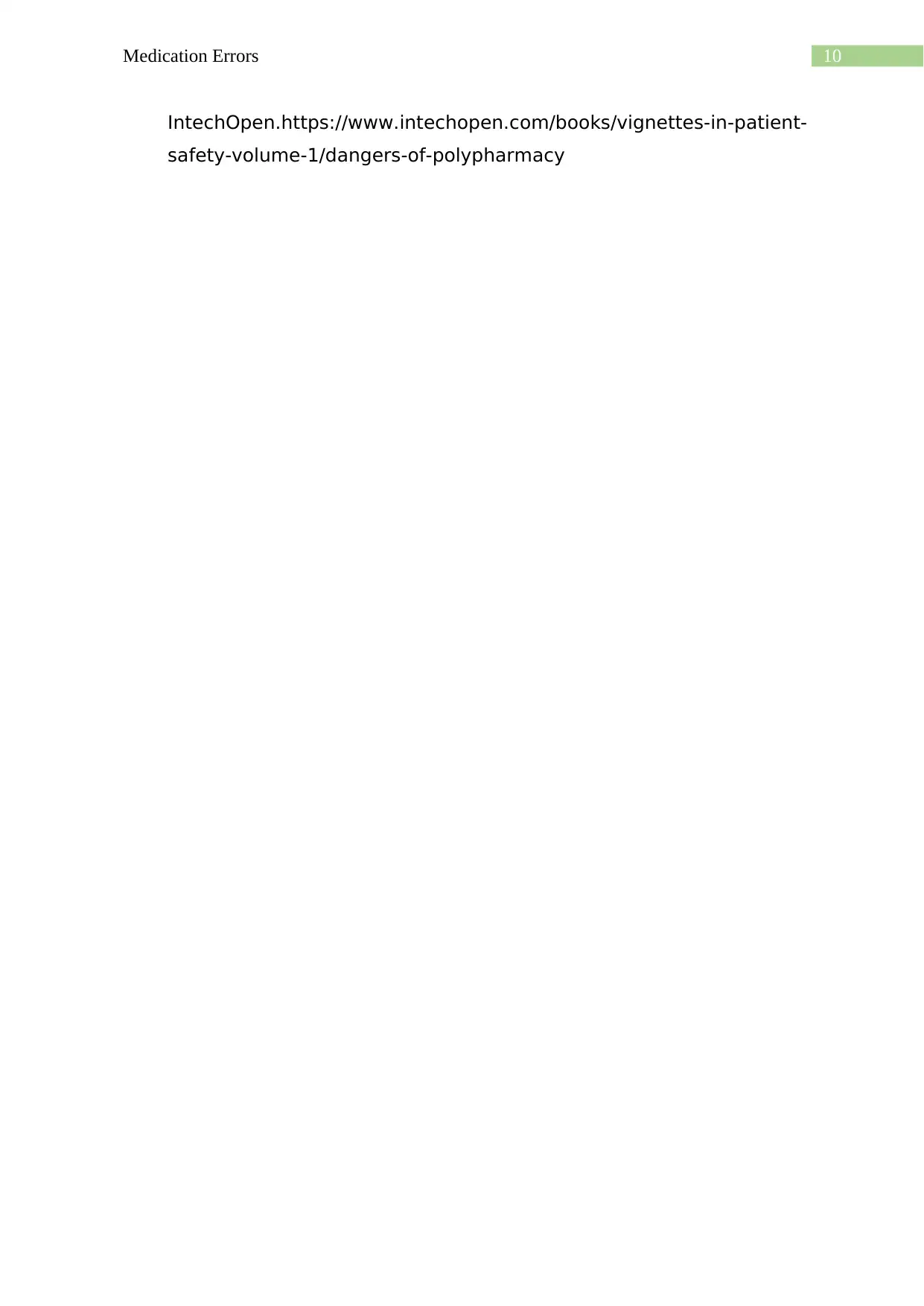
10Medication Errors
IntechOpen.https://www.intechopen.com/books/vignettes-in-patient-
safety-volume-1/dangers-of-polypharmacy
IntechOpen.https://www.intechopen.com/books/vignettes-in-patient-
safety-volume-1/dangers-of-polypharmacy
1 out of 11
Related Documents
Your All-in-One AI-Powered Toolkit for Academic Success.
+13062052269
info@desklib.com
Available 24*7 on WhatsApp / Email
![[object Object]](/_next/static/media/star-bottom.7253800d.svg)
Unlock your academic potential
© 2024 | Zucol Services PVT LTD | All rights reserved.





